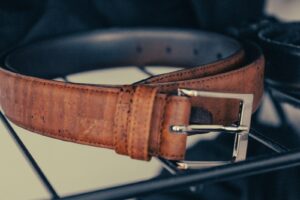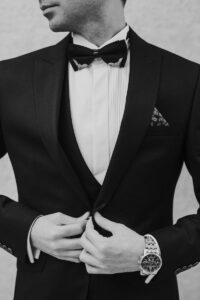When it comes to formal attire, few ensembles rival the timeless elegance of a tuxedo. Yet, a common question arises: can you wear a belt with a tuxedo? Traditionally, tuxedos are designed to offer a sleek, uninterrupted line, often relying on side adjusters or suspenders for a perfect fit. However, fashion evolves, and modern takes on tuxedos sometimes include belt loops, making room for a stylish belt.
If you’re considering adding a belt to your tuxedo, it’s crucial to make thoughtful choices. A slim, high-quality leather belt in matte or gloss black can complement a classic black tuxedo, while a dark blue or black belt suits a navy ensemble. The key is to ensure the belt doesn’t disrupt the formal aesthetic. In less formal settings, a belt might enhance your look, provided it aligns with your tuxedo’s style and color.
The Belt Dilemma: To Wear or Not to Wear with a Tuxedo
Navigating the question of “can you wear a belt with a tuxedo?” can be challenging. Traditionally, tuxedo trousers lack belt loops, designed instead for a sleek look without interruptions. Suspenders, or tuxedo suspenders as they’re often known, are typically worn in place of a belt, preserving the formal nature of the ensemble.
When considering wearing a belt with a tuxedo, factors like the event’s formality and personal style choices come into play. At a black tie event, a classic tuxedo with a shawl lapel or dinner jacket usually pairs better with suspenders or a cummerbund to maintain the elegance of the attire. If opting for a belt, select a slim, black leather belt that complements your tuxedo’s style without disrupting its classic appearance.
In less formal occasions, personal preference might allow incorporating a belt into the tuxedo ensemble. However, ensuring that the belt matches elements like the black bow tie and dress shirt is crucial to keep the look cohesive. Avoid brown belts or shoes, which can introduce a more casual appearance conflicting with formal attire.
Ultimately, wearing a belt with a tuxedo depends on understanding the dress code and desired level of formality. In modern styles, where tuxedo pants have belt loops, a belt can be a viable option if it aligns with the overall outfit and occasion.
Understanding Tuxedo Style
Understanding the intricacies of tuxedo style is essential when contemplating whether to wear a belt with a tuxedo. Its traditional elegance lies in details such as the cut of the tuxedo jacket and the fit of the tuxedo trousers.
The Traditional Design of Tuxedo Pants
Tuxedo pants are traditionally designed without belt loops to maintain a seamless look, relying instead on side adjusters or suspenders. The absence of belts aligns with the broader tuxedo ensemble designed for formal wear at events like black-tie gatherings. Tuxedo suspenders not only serve a functional purpose by keeping pants at the proper height but also enhance the outfit’s elegance. A cummerbund or waistcoat often accompanies the tuxedo, contributing to a sleek and polished appearance. Satin accents on lapels and side seams further differentiate tuxedo pants from regular suit trousers, emphasizing their formal nature.
Modern Trends and Belt Usage
Modern trends in tuxedo fashion, however, reveal a shift as some tuxedo trousers now come with belt loops. This inclusion provides the opportunity to wear a belt with a tuxedo, especially for those favoring a more contemporary style. Despite this option, wearing a belt remains a stylistic decision involving personal preference and event formality considerations. If opting for a belt, choosing a slim, black leather belt that complements the tuxedo’s color is crucial. For less formal occasions, matching the belt with elements like a black bow tie or pocket square can achieve a cohesive look. Yet, at formal events, staying traditional with suspenders or cummerbunds generally preserves the tuxedo’s classic elegance.
Dos and Don’ts of Wearing a Belt with a Tuxedo
When considering whether to wear a belt with a tuxedo, it’s essential to follow specific guidelines to ensure an elegant appearance. Though traditional tuxedos typically exclude belts, personal style and modern variations can make room for this accessory.
When It’s Appropriate to Wear a Belt
Wearing a belt with a tuxedo can be suitable if the tuxedo pants have belt loops and the event is less formal, such as a cocktail gathering rather than a black-tie event. In this case, select a slim black leather belt to maintain the formality of the tuxedo ensemble. The belt should match other accessories like the bow tie and pocket square to achieve a cohesive look. A similar shade among tuxedo accessories prevents contrast with the elegant ensemble.
Situations to Avoid Wearing a Belt
Avoid wearing a belt at formal events like black-tie or white-tie occasions, where tradition dictates that tuxedo suspenders or a cummerbund should pair with the attire. Tuxedo trousers typically don’t include belt loops for high-level formal events, emphasizing a streamlined style. Moreover, avoid bulky belts that may disrupt the smooth lines of a tuxedo jacket and create a more casual appearance, which is unfavorable in sophisticated settings. Instead, rely on well-fitted tuxedo suspenders to uphold an elegant, traditional tuxedo style.
Alternative Accessories to Belts
Traditionally, tuxedos eschew belts to maintain their sleek, elegant appearance. Instead, other accessories enhance the formal attire’s style and support. Here’s how these alternatives can elevate your tuxedo ensemble.
Choosing Suspenders Over Belts
Suspenders serve as a classic option for maintaining a tuxedo’s fit and style. They adjust tuxedo trousers to the correct height, providing a smooth silhouette without the need for belt loops. In my experience, black or white suspenders complement formal events, especially when paired with a black bow tie and white dress shirt. They’re not only functional but also add a touch of refinement to the tuxedo outfit.
The Role of Cummerbunds
Cummerbunds offer a traditional alternative to belts. This sash-like accessory wraps around the waistline, ensuring the tuxedo pants stay in place. Originating in Victorian-era England, cummerbunds provide not only a practical function but also a visually appealing layer beneath the tuxedo jacket. For black tie events, cummerbunds help maintain the formal look while also providing a place to discreetly store small items in their pleats.
The Belt-less Option: A Minimalist Approach
For a modern, minimalist approach, consider removing the necessity for waist accessories altogether. A perfectly fitted tuxedo jacket and trousers eliminate the requirement for both belts and suspenders. This approach suits those opting for a contemporary take on tuxedo’s style. By focusing on a tailored fit and cohesive elements like a matching bow tie and white dress shirt, the streamlined appearance speaks to the tuxedo’s inherent elegance without additional adornments.
Perfecting Your Tuxedo Look
Enhancing a tuxedo ensemble involves more than just selecting the right pieces. Accessories and fit play an essential role in achieving a refined appearance at a formal occasion.
Selecting Coordinated Accessories
Tuxedo accessories transform a standard outfit into a distinctive ensemble. A black bow tie stands as a classic choice, matching the formal attire’s tones. Pairing a white pocket square with the tuxedo jacket adds elegance, while cufflinks provide a personalized touch. Tuxedo shoes, preferably patent leather oxfords, elevate the appearance further. If wearing a boutonnière, choose a subtle flower that complements the jacket’s color.
Ensuring a Proper Fit
A flawless fit ensures that tuxedo trousers and jackets accentuate the wearer’s frame. Traditional tuxedo trousers often forgo belt loops, relying on tuxedo suspenders to maintain the fit and elegance. A tailored tuxedo jacket, whether with a shawl lapel or peak lapel, enhances the figure. For those contemplating the modern touch, wearing a suitable belt depends on personal preference and whether it’s compatible with the overall look. The tuxedo shirt and jacket should fit seamlessly to avoid disrupting the ensemble’s sleek line.
Navigating the nuances of wearing a belt with a tuxedo boils down to understanding the event’s formality and your personal style. While traditional tuxedos thrive on suspenders or cummerbunds for their timeless elegance, modern designs with belt loops offer flexibility. If you choose to wear a belt, ensure it’s a slim, high-quality leather piece that seamlessly integrates with your ensemble. Remember, the key to a polished tuxedo look lies in the details—from accessories like bow ties and pocket squares to the impeccable fit of your jacket and trousers. By balancing tradition with modern sensibilities, you can confidently step into any formal setting with style.
Wearing a belt with a tuxedo is generally considered a fashion faux pas, as tuxedos are designed to exude a clean and seamless look without the need for a belt. Instead, opt for suspenders or side adjusters to maintain the classic elegance of formalwear. As you refine your wardrobe, consider exploring how to style a monochrome outfit for a chic, modern look or elevate your home bar with elegant glassware. For more lifestyle inspiration, dive into the benefits of yoga, afternoon tea traditions, or add a touch of sophistication to your space with handmade rugs.
Frequently Asked Questions
Can you wear a belt with a tuxedo?
Traditionally, wearing a belt with a tuxedo is not recommended, as tuxedo pants typically have side adjusters or suspenders instead of belt loops. However, modern designs may have belt loops, allowing for a slim, high-quality leather belt that matches the tuxedo’s color—only in less formal settings. At formal events like black-tie affairs, it’s best to avoid belts and stick with suspenders or a cummerbund.
What is the purpose of suspenders with a tuxedo?
Suspenders serve a functional purpose by keeping tuxedo trousers at the proper height, ensuring a polished appearance throughout an event. They also contribute to the outfit’s elegance, providing a traditional and refined look without the need for a belt. Black or white suspenders are ideal for formal events, as they complement the overall attire without distracting from the tuxedo’s sophistication.
Why should you avoid wearing a brown belt with a tuxedo?
A brown belt detracts from the formal nature of a tuxedo. Tuxedos are typically paired with black or dark colors to maintain a cohesive and elegant appearance. Brown belts, especially with black shoes, can clash and disrupt the intended sleek look of a tuxedo. It’s best to stick with black accessories for a more classic and sophisticated style.
Are there alternatives to wearing a belt with a tuxedo?
Yes, there are several alternatives to belts for a tuxedo. Suspenders are a traditional option that maintains the pants’ fit without belt loops. Cummerbunds offer practical support and add a visually appealing layer beneath the jacket. For a modern look, a perfectly tailored tuxedo can eliminate the need for belts and suspenders, focusing on a sleek, tailored fit for elegance.
How does the fit of a tuxedo impact its appearance?
A flawless fit is crucial for a tuxedo’s elegance. The jacket and trousers should accentuate the wearer’s frame, maintaining a seamless silhouette. Tuxedo trousers are often designed without belt loops to achieve a clean line. Proper tailoring ensures all elements, such as the jacket, shirt, and accessories, work harmoniously to create a sophisticated and cohesive appearance.



